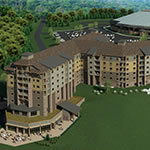Camelback Lodge & Aquatopia Indoor Waterpark, set to open in the spring of 2015 as the largest indoor waterpark in the northeastern United States, is currently under construction in the Pocono Mountains of eastern Pennsylvania. In addition to rides with unprecedented designs, including North America’s longest uphill “watercoaster” and a ride called the Venus SlydeTrap, a thoughtful resource-conserving design underlies its theme of four-season family fun.
“The owners expressed a very strong desire to invest in green features at the outset,” says Bill Ryan of ADCI (Architectural Design Consultants Inc.), lead architect on the 453-room expansion of the Camelback Mountain’s historic ski resort, which will include the 125,000-square-foot waterpark.
 Waterparks are not typically known for water conservation, but based on a directive from Camelback’s owners Arthur Berry III and Ken Ellis and their partners at Waterpark Ventures Management Services—the resort’s operator and a major equity investor in the project—the designers went to work looking at all options to reduce water use and create a healthy indoor environment to match the pristine surroundings. “Whenever we have an option to select a green feature we try to capitalize on it,” says Pete Helland of Waterpark Ventures Management Services. After examining possibilities for greywater recycling and rainwater catchment, the team determined that investing in a high water-reuse filtration system yielded the best cost-benefit ratio, resulting in a 30-percent reduction in use over a baseline filtration system.
Waterparks are not typically known for water conservation, but based on a directive from Camelback’s owners Arthur Berry III and Ken Ellis and their partners at Waterpark Ventures Management Services—the resort’s operator and a major equity investor in the project—the designers went to work looking at all options to reduce water use and create a healthy indoor environment to match the pristine surroundings. “Whenever we have an option to select a green feature we try to capitalize on it,” says Pete Helland of Waterpark Ventures Management Services. After examining possibilities for greywater recycling and rainwater catchment, the team determined that investing in a high water-reuse filtration system yielded the best cost-benefit ratio, resulting in a 30-percent reduction in use over a baseline filtration system.
Most indoor waterparks are housed in warehouse-like structures with little natural light and massive heating and cooling costs. Aquatopia, however, is getting a transparent Texlon roofing system on its southern half, allowing for year-round sunbathing and stargazing, as well as plenty of natural light for the lush plantscape that will be installed. “It can be five degrees outside in January, but when you walk in, it’s going to feel very tropical, which makes all the difference in establishing the atmosphere for our guests,” Helland says.
The passive solar effect will be aided by the thermal absorption of Aquatopia’s seven pools in winter, and in summer, giant fans will create an evaporative cooling effect to keep the space from overheating. “We’re not using any air-conditioning,” Ryan says, “just moving the air.”
The hotel room thermostats also use simple technology to ensure energy efficiency. Guests insert their key cards to raise and lower their rooms’ temperatures as they please, but when they leave and take the key card with them, the thermostat automatically drops to 60 degrees, ensuring that heat isn’t wasted when the room is empty.

